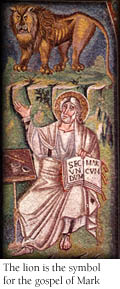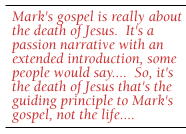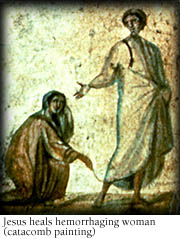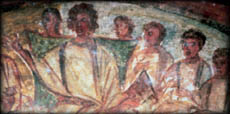The Gospel of Mark
A story of secrecy and misunderstanding.Professor of Classics and Director of the Religious Studies Program University of Texas at Austin
WHO IS MARK?
 According to tradition, the author, Mark is not an apostle himself. Not one of
the original disciples, but rather the follower of one of them. Traditionally,
he's supposed to be the disciple of Peter .... We don't know exactly where this
Mark was or where he actually wrote. However, tradition places him at Rome,
but one more tradition also has him located at Alexandria, and it may be the
case that the story that we call Mark's gospel, which supposedly derived from
Peter, is also an example of this passing on of an oral tradition. It owes its
history to Mark, whether Mark is the person who actually wrote it down or not.
According to tradition, the author, Mark is not an apostle himself. Not one of
the original disciples, but rather the follower of one of them. Traditionally,
he's supposed to be the disciple of Peter .... We don't know exactly where this
Mark was or where he actually wrote. However, tradition places him at Rome,
but one more tradition also has him located at Alexandria, and it may be the
case that the story that we call Mark's gospel, which supposedly derived from
Peter, is also an example of this passing on of an oral tradition. It owes its
history to Mark, whether Mark is the person who actually wrote it down or not.
SIGNIFICANCE OF MARK
 Why is the Gospel of Mark important, in early Christianity?
Why is the Gospel of Mark important, in early Christianity?
Mark's is the first of the written gospels. It's really the one that establishes... the life of Jesus as a story form. It develops a narrative from his early career, through ...the main points of his life and culminat[es] in his death. And, as such, it sets the pattern for all the later gospel traditions. We know that both Matthew and Luke used Mark, as a source in their composition and it's also probable that even John knew something of Mark in tradition. So, Mark is really the one that sets the stage for all the later Christian gospel writings.
SECRECY AND MISUNDERSTANDING
Mark retells the story of Jesus. He starts by taking a number of elements of earlier oral tradition. Mark seems to have a knowledge of at least one and maybe two or three different collections of miracle stories as a source. He weaves these together with other stories about Jesus, about teachings, about travels, about other things and makes those a part of his understanding of how Jesus' life worked and what it was intended to do. But, in the final analysis, Mark's gospel is really about the death of Jesus. It's a passion narrative with an extended introduction, some people would say. Mark tells the story by thinking about the death and letting all the events that lead up to that death move toward it and through it. So, it's the death of Jesus that's the guiding principle to Mark's gospel, not the life....
Mark tells the story this way in order to make sense out of the death of Jesus and in the light of the events of the first revolt. Those are the two guiding principles really of the story line of Mark....
For Mark, Jesus is a somewhat enigmatic figure and that's very important to his way of telling the story. Jesus is mysterious. Jesus intentionally keeps people from understanding who he really is, at times. At times, Jesus actually silences the demons who would announce his true identity. When he performs a miracle, he tells people, don't say anything to anyone about what I have done. He even takes the disciples away, off into a corner, and teaches them privately so that others won't hear and understand the message. He seems to be a very secretive kind of figure in Mark's gospel.
Now, why does Mark tell the story this way? It seems to be the case that he uses this motif of secrecy and misunderstanding as a way of reconceptualizing the image of Jesus. There's something about the the previous understandings of Jesus, even within the Christian community, that Mark feels compelled now to correct and to give a new meaning for, and it probably has something to do with the post-war experience. Why had it all happened? What had gone wrong? Why was Jerusalem destroyed? Mark tells the story in such a way to make sense out of that, in the light of the death of Jesus.
MORE THAN A MIRACLE WORKER
The fact that Mark takes these early oral sources of Jesus miracle stories suggests that, in fact, one of the earliest ways of understanding Jesus is as a miracle worker. But miracle workers are a dime a dozen in the ancient world. We hear about all sorts of people who can perform miracles, so that doesn't really seem to set him apart. There's nothing unique about that in antiquity. We hear of Jewish miracle workers, pagan miracle workers, good miracle workers, bad miracle workers. It seems to be one of the points of Mark's gospel to say, "he's not just a miracle worker; he's more." Mark actually has Jesus unable to perform miracles at certain times, or unwilling to perform them. In one case, he even has to perform a miracle twice in order to get it right. In another case, he heals a boy to death and has to bring him back to life later. So, Jesus is a peculiar kind of miracle worker, in the way he's described in Mark's gospel and it seems to be that that's one of Mark's concerns.
MARK'S MESSIAH MUST DIE
One of the main issues in Mark's way of presenting Jesus is what it means for Jesus to be the Messiah. Now, it's true that within the gospel, many different people understand that he is the Messiah. At one point, he asks the disciples, "who do you think I am?" and they clearly say, "you're the Messiah." And yet, one of the most important dramatic elements in Mark's gospel is that even when they confess that he is the Messiah, they clearly do not understand the significance of his Messianic identity. Mark's gospel is playing with that issue, is forcing that issue to the front for his audience and saying this is the key point. It's what the disciples failed to understand that you must understand, and the whole point of Jesus' Messianic identity in Mark's gospel is that he had to die....
It's not always clear that he really thinks of himself as the Messiah all the way throughout his career and even when the disciples confess that he's the Messiah, even when they come to understand him as the Messiah, they don't really realize that he must die, that that's part of his Messianic identity. So, Mark is really telling us that to be the Messiah, [means] more than just being a miracle worker or just teaching wonderful teachings. There's something else at stake here.
DISCIPLES MISS THE POINT
Mark's gospel is a brilliant piece of dramatic composition because it allows this motif of secrecy and misunderstanding to be the occasion for bringing together a number of the key symbolic moments in the story of Jesus. So, while the disciples, his closest friends and followers, failed to understand his true identity, ... failed to understand that he will die as part of his Messianic identity, there are a number of marginal characters in this story who seem to understand him more correctly and more properly, without prompting and without instruction. In one sense, it's the marginal characters who provide the kind of dramatic foil for the Markan story. One of the best example is the story of the woman who just at the Last Supper of Jesus comes and anoints his feet and the disciples criticize her for for anointing him. Jesus says, "she's already anointed me for my burial and her action will be remembered." So, she sees something that the disciples themselves fail to see, and it's the women, the marginal characters, the demons, those on the periphery of the story who often carry the important realizations of Jesus' true identity. It's it's really quite a marvelous dramatic presentation....
JAIRUS' DAUGHTER

One of the best examples of Mark's literary craft is the way he weaves stories together. A good example is the double miracle of the raising of Jairus daughter and the healing of the woman with the hemorrhage or menstrual disorder. Now originally, these must have been two completely distinct and independent miracle stories. Mark puts them together by actually weaving the story of the little girl who dies, around the story of the older woman who is healed, and we can see that Mark is telling the story in such a way, as to make the stories read together, to make elements from one miracle flow into the other. For example, the little girl is 12 years old....
The way Mark tells the story, it goes like this. Jesus is on his way one day, and is asked to come heal the young daughter, age 12, of a prominent synagogue official. His name is Jairus. While Jesus is on the way to heal this little girl, he's going through the crowds and all of a sudden he's touched by a woman with a menstrual disorder. This interrupts the story momentarily and it's at this point that we actually see Mark inserting into the story of Jairus' daughter this separate miracle about the woman. Now, in the encounter between Jesus and the woman we have a very interesting play of symbols. ... The woman has a menstrual disorder. She's had it for 12 years, the same length of time that the little girl has been alive. So, the two elements in the story are starting to play together. The fact that the woman touches Jesus, though, because of purity regulations, means that she would have in fact, made Jesus impure. He shouldn't now be going to deal with a synagogue official, after having been contaminated by her impurity. So, there are plays of purity and impurity, of age, of her womanly status and the virginal status of the little girl and so on. There are a number of these kinds of dramatic elements that play through the story. So, each story is being set up to play off of the other.
What's significant is the woman is the one who recognizes Jesus, and reaches out and touches him and at that very moment is immediately healed. He doesn't do a thing. He feels the power rush from him and only then turns to encounter her and comment on her faith. In the process, while delaying to deal with her, the little girl dies and now when he proceeds on to the next stage of the story, he has to not only heal her but raise her from the dead....The dramatic conclusion to the story is when Jairus greets Jesus at the door and says never mind, she's already dead. Jairus, the synagogue official, doesn't understand who Jesus really is, what he can really do. He doesn't know what the woman did and yet, she's the last kind of person you would have expected to have that kind of religious knowledge in the first century. She's a marginal character and yet she brings a great deal of insight to Jesus' true identity.
Then Jesus proceeds to raise the little girl from the dead, thereby proving what his powers are really all about, after all, and in some ways, it's a kind of a symbolic moment because it's all foreshadowing his own resurrection from the dead....
MARK'S POST-REVOLT AUDIENCE
What gives us the insight into the situation of the writing of Mark's gospel are some internal pieces of evidence about the way he tells the story, about the audience that he's trying to address. One of the best of these comes in Mark 13, what is sometimes called the Little Apocalypse, because in it, Jesus has just come out of the Temple and his disciples turn and point to the magnificent structure and say, "isn't it all beautiful? What do you think, Jesus?" Jesus proceeds then to tell them about the destruction of the Temple. So, here is a story of Jesus, some 40 years before the Temple is destroyed, already predicting the destruction. But, as this story unfolds, it becomes clear that the audience for whom it is written has seen the destruction of the Temple, that whatever Jesus' predictions are supposed to suggest, that they themselves know it first hand.
The key comes, when Jesus is made to refer to the desolating sacrilege, which is set up where it ought not to be and then it says, "let the reader understand." Jesus never wrote anything. Who would be reading this in his day? It's as if we've had a soliloquy where the author, Mark, steps out from behind the character, Jesus, and addresses his audience, first hand, from their own experiences, from their own immediate past history. This is where we see the situation of the revolt and its aftermath really being a very important stimulus to the writing of these gospels.
PARABLES CONCEAL TRUE MESSAGE
 One of the peculiar features of Mark's gospel in its presentation of Jesus is
that, when Jesus teaches he often actually conceals the significance of his own
words from the the popular audiences, and directs it only to his own disciples.
Everyone will recognize that Jesus teaches in parables. But, in Mark's gospel,
when Jesus teaches in parables, it says explicitly that he does so in order to
keep people from understanding his messages. He teaches in these metaphors and
in these word pictures so that people will not understand. It's a very
different understanding of Jesus than what we might have assumed,
traditionally, I think....
One of the peculiar features of Mark's gospel in its presentation of Jesus is
that, when Jesus teaches he often actually conceals the significance of his own
words from the the popular audiences, and directs it only to his own disciples.
Everyone will recognize that Jesus teaches in parables. But, in Mark's gospel,
when Jesus teaches in parables, it says explicitly that he does so in order to
keep people from understanding his messages. He teaches in these metaphors and
in these word pictures so that people will not understand. It's a very
different understanding of Jesus than what we might have assumed,
traditionally, I think....
This motif of Jesus concealing things and the fact that the disciples characteristically misunderstand is part of Mark's way of re-interpreting the story of Jesus for the post-war audience. They're the ones who are supposed to understand. Mark is really taking a stock of traditional stories about Jesus that have been passed on now, through oral tradition. And, is assembling those in such a way as to provide a new interpretation, a new experience of Jesus, for his audience....
The fact that Mark is clearly reflecting on the destruction of the Temple as part of his understanding of the significance of the life and death of Jesus is a crucial interconnection in this gospel. By interweaving stories, Mark also makes the death of Jesus and the rejection of Jesus central to the story that results in the destruction of the Temple. Thus, the story of the cleansing of the Temple in Mark's gospel is really Jesus' way, according to Mark, of showing that the Temple is not bearing its proper fruit. Jesus also then curses a fig tree and the two stories are woven together, in Mark, in such a way that the symbolism carries over from one to the next. Jesus is standing against the Temple, in Mark's gospel and Mark wants us to understand that that's significant to why he must die and why Jerusalem will be destroyed.
DEATH OF JESUS IN MARK
Mark's gospel is also the first one that really tells us the passion narrative in as much detail. And the way Mark tells the tells the story of the death of Jesus... is to see him as a lonely figure who goes to his death abandoned by all of his followers and supporters and even abandoned by his God. Jesus from the cross says ..., "My God, my God, why have you forsaken me"? The Jesus of Mark's gospel is a lonely figure, at times, waiting for the vindication of God.
John H. Morison Professor of New Testament Studies and Winn Professor of Ecclesiastical History Harvard Divinity SchoolJESUS IN MARK - THE MESSIANIC SECRET
When Mark writes his gospel, he is already aware of very different images of Jesus or beliefs [about] who Jesus was.... One is the belief that Jesus is the Messiah because of the great miracles that he has done, and because of his powerful teaching, his healing, his walking on the sea. And Mark picks up that tradition, but he picks it up in a critical fashion. He does not deny that Jesus did these miracles, but he sums up Jesus' miracle activity in the question in the middle of the gospel of the famous confession of Peter at Caesarea Philippi in Chapter 8, [where] Jesus asks the disciples, "Who do you think I am?" And Peter knows exactly who the one is who has done all these miracles. And says, "You are the Christ. You are the Messiah." And from then on comes a sharp turning point in the Gospel of Mark that tells the reader that to believe that Jesus was the Messiah because he did miracles is not a real understanding of who Jesus was. Because immediately after the confession of Peter, Jesus says, "the Son of Man has to suffer and to die." And Peter says, "This should not happen to you," and Jesus rebukes him as Satan....
The Gospel of Mark has for many years been discussed under the question of "the messianic secret." And there are a host of scholarly opinions, over a 100 years now of scholarship, about "what is the messianic secret?" It seems to me that the messianic secret is, indeed, that the true messiahship of Jesus cannot be recognized in his miracles. The disciples as they witness the miracles don't understand. They don't know what is going on. They are taught to understand from the prediction of the passion onwards who Jesus is. And that the messianic secret of Jesus is that he is the son of man who has come to suffer and not the Messiah who is going to do great miracles. And that will become clear only at the very end of the story of Jesus. And it is only the story of the suffering and the death of Jesus reveals that the secret of Jesus, and reveals who Jesus really is.
![]()
Read more on the Gospel of Mark in this essay by Marilyn Mellowes.
